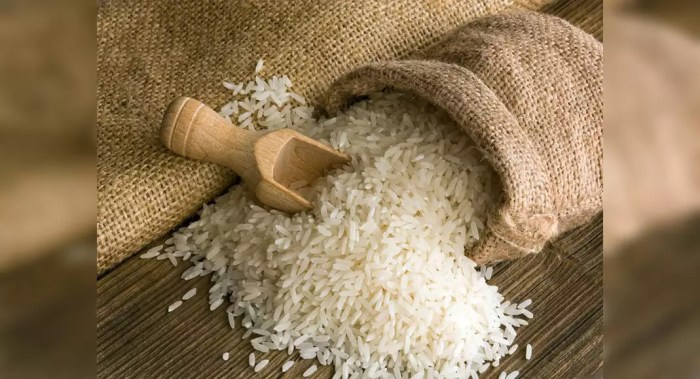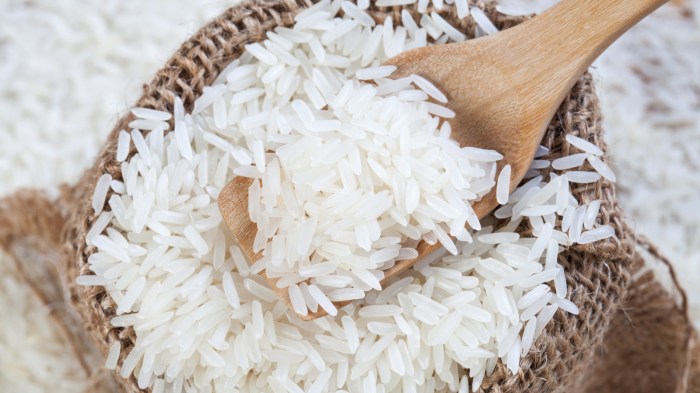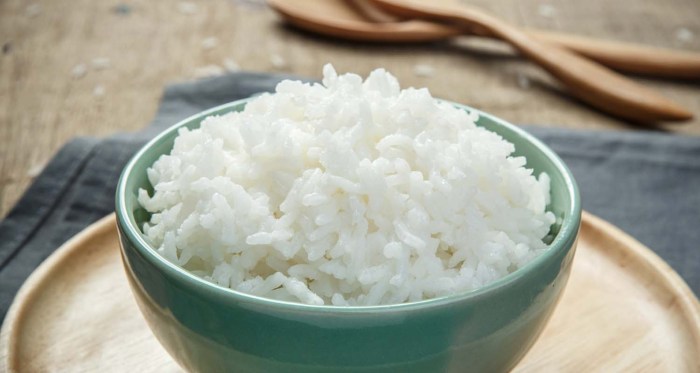Rice hack recipes offer a world of culinary possibilities, transforming the humble grain into a versatile ingredient for countless dishes. Beyond its simple preparation, rice can be a canvas for creativity, accommodating diverse flavors, textures, and culinary techniques.
This guide delves into the art of rice hacks, exploring innovative methods to enhance flavor, manipulate texture, and repurpose leftovers. We’ll cover everything from incorporating spices and herbs to creating unique rice textures and transforming leftover rice into exciting new dishes.
Introduction to Rice Hacks

Rice is a staple food enjoyed worldwide, its versatility making it a blank canvas for countless culinary creations. From simple side dishes to elaborate entrees, rice adapts effortlessly to diverse flavors and textures. However, cooking rice can present its own set of challenges, often leading to inconsistent results.
Common issues include achieving the perfect texture, maintaining flavor, and managing time constraints. This is where “rice hacks” come in, offering creative solutions to elevate basic rice dishes and overcome these culinary hurdles.
Rice Hacks: Techniques and Solutions
Rice hacks encompass a range of techniques and solutions designed to enhance the cooking process and final product. These hacks address common issues like overcooked rice, bland flavor, and time limitations, making it easier to prepare delicious and satisfying rice dishes.
Flavor Enhancing Hacks: Rice Hack Recipe
Flavoring your rice during cooking is a simple way to elevate your meal and create delicious and unique dishes. Adding spices, herbs, and aromatics not only enhances the taste but also adds depth and complexity to your rice.
Spice and Herb Combinations
Incorporating spices and herbs during the cooking process infuses the rice with a delightful aroma and flavor. Here are some examples of spice and herb combinations to try:
- Classic Indian:A blend of turmeric, cumin, coriander, and garam masala provides a warm and earthy flavor.
- Mediterranean:A mix of oregano, thyme, rosemary, and garlic creates a fragrant and savory rice.
- Latin American:A combination of cilantro, cumin, paprika, and lime juice adds a bright and zesty flavor.
- Asian-inspired:A blend of ginger, garlic, soy sauce, and sesame oil creates a savory and umami-rich rice.
Flavor Profile Combinations
Creating specific flavor profiles is easy with the right spice and herb combinations. Here’s a table showcasing various flavor combinations and their corresponding ingredients:
| Flavor Profile | Ingredients |
|---|---|
| Asian-inspired | Ginger, garlic, soy sauce, sesame oil, scallions, cilantro |
| Mediterranean | Oregano, thyme, rosemary, garlic, lemon juice, olive oil |
| Latin American | Cilantro, cumin, paprika, lime juice, onions, garlic |
| Indian | Turmeric, cumin, coriander, garam masala, cardamom, cinnamon, bay leaves |
Texture and Consistency Hacks
Rice texture is a key factor in how you enjoy your meal. Different cooking methods and techniques can lead to a wide range of textures, from fluffy and light to sticky and creamy.
Understanding the Impact of Cooking Methods
The cooking method significantly influences rice texture. For instance, steaming produces fluffy and separate grains, while simmering in a pot with minimal water creates a sticky and cohesive texture.
Achieving Desired Rice Textures
Fluffy Rice
Fluffy rice is ideal for dishes like fried rice or pilaf. To achieve this texture, use a ratio of 1:2 (rice to water) and cook using the absorption method. This involves bringing the water to a boil, then reducing heat and simmering until the water is absorbed.
Avoid stirring during cooking to prevent breaking the grains.
Sticky Rice
Sticky rice is a staple in many Asian cuisines and is perfect for sushi or rice balls. This texture is achieved by using a ratio of 1:1.5 (rice to water) and simmering the rice until the water is absorbed.
Creamy Rice
Creamy rice, often found in risotto or rice pudding, is achieved by using a slow-cooking method. This involves gradually adding hot broth or milk to the rice, stirring constantly, until the rice is cooked through and has absorbed all the liquid.
Rice Types and Ideal Cooking Methods
The type of rice also plays a role in achieving the desired texture. Here’s a table summarizing different rice types and their ideal cooking methods for specific textures:| Rice Type | Ideal Texture | Cooking Method ||—|—|—|| Long Grain Rice | Fluffy | Absorption Method || Medium Grain Rice | Sticky | Simmering || Short Grain Rice | Creamy | Slow Cooking || Arborio Rice | Creamy | Risotto Method || Jasmine Rice | Fluffy | Absorption Method || Basmati Rice | Fluffy | Absorption Method |
Leftover Rice Transformations
Don’t let leftover rice go to waste! It’s a versatile ingredient that can be transformed into a variety of delicious and satisfying meals. From quick and easy breakfast options to hearty dinners, leftover rice can be the star of the show.
Repurposing Leftover Rice
Repurposing leftover rice is a fantastic way to reduce food waste and create new and exciting dishes. You can use it to create a variety of meals, including:
- Rice Salads:Combine leftover rice with your favorite vegetables, herbs, and a tangy dressing for a refreshing and light meal.
- Rice Fritters:Mix leftover rice with spices, herbs, and vegetables, then form into patties and pan-fry for a crispy and flavorful snack or appetizer.
- Stir-Fries:Leftover rice is the perfect base for a quick and easy stir-fry. Add your favorite vegetables, protein, and sauce for a satisfying meal.
- Rice Bowls:Create a customizable rice bowl by layering leftover rice with various toppings like roasted vegetables, grilled chicken or tofu, and a flavorful sauce.
Incorporating Leftover Rice into Meals
Leftover rice can be incorporated into various meals throughout the day:
Breakfast
- Rice Pudding:A classic comfort food, rice pudding can be made with leftover rice, milk, sugar, and spices. It’s a warm and comforting breakfast option.
- Rice Pancakes:Combine leftover rice with eggs, milk, and flour to create savory pancakes. Serve with your favorite toppings like cheese, avocado, or salsa.
- Fried Rice:A quick and easy breakfast option, fried rice can be made with leftover rice, eggs, vegetables, and soy sauce.
Lunch
- Rice Salad Sandwiches:Use leftover rice as a filling for sandwiches, combining it with vegetables, cheese, and a dressing for a hearty and flavorful lunch.
- Rice Soup:Leftover rice can be added to soups for extra texture and substance. It can be used in chicken noodle soup, vegetable soup, or even a creamy tomato soup.
- Rice Wraps:Use leftover rice as a filling for wraps, combining it with vegetables, protein, and a sauce for a quick and easy lunch.
Dinner
- Rice Pilaf:Add leftover rice to a flavorful pilaf made with vegetables, herbs, and spices. Serve it alongside grilled chicken or fish for a complete meal.
- Rice Casserole:Combine leftover rice with cheese, vegetables, and a creamy sauce for a comforting and satisfying casserole.
- Rice Balls:Form leftover rice into balls, coat them in breadcrumbs, and deep-fry or bake for a crispy and flavorful appetizer or side dish.
Freezing Leftover Rice
Freezing leftover rice is a great way to preserve it for future use. Here’s how to freeze leftover rice and prevent freezer burn:
- Cool the rice completely:Allow the rice to cool to room temperature before freezing.
- Store in airtight containers:Transfer the cooled rice to airtight containers or freezer bags, squeezing out as much air as possible.
- Label and date the container:Label the container with the date to ensure you use the rice within a few months.
- Freeze for up to 3 months:Leftover rice can be frozen for up to 3 months without compromising its quality.
Tip:To prevent freezer burn, you can wrap the container in plastic wrap before placing it in a freezer bag.
Rice Hack Equipment and Tools

The right equipment can significantly enhance your rice-cooking experience, making it easier to achieve the perfect texture and consistency. From basic essentials to specialized appliances, there are various tools that can elevate your rice hacks.
Rice Cookers
Rice cookers are specifically designed for cooking rice, offering convenience and consistent results.
Understand how the union of grinch punch recipe can improve efficiency and productivity.
- Advantages:Rice cookers are user-friendly, often featuring automatic settings for different rice types and cooking modes. They require minimal supervision, allowing you to multitask while the rice cooks. They also maintain the rice warm after cooking, preventing it from drying out.
- Disadvantages:Rice cookers can be bulky and require dedicated storage space. They may not be suitable for small kitchens or those with limited counter space. While they offer convenience, they may not be as versatile as other cooking methods, limiting the types of rice dishes you can prepare.
Pressure Cookers
Pressure cookers can cook rice quickly and efficiently, significantly reducing cooking time.
- Advantages:Pressure cookers utilize steam pressure to cook rice faster than traditional methods. They are energy-efficient, consuming less energy than conventional cooking methods. They can also be used for various other cooking tasks, making them a versatile kitchen appliance.
- Disadvantages:Pressure cookers can be intimidating for some users, requiring careful handling and understanding of safety precautions. They may not be suitable for individuals with limited cooking experience. They can also be noisy during operation.
Dutch Ovens, Rice hack recipe
Dutch ovens are versatile cookware that can be used for various cooking methods, including rice cooking.
- Advantages:Dutch ovens are durable and can withstand high temperatures. They distribute heat evenly, ensuring consistent cooking. They can also be used on the stovetop, in the oven, or over a campfire, making them ideal for diverse cooking situations.
- Disadvantages:Dutch ovens can be heavy and bulky, making them less convenient for everyday use. They require more attention during cooking, as they may need frequent stirring to prevent scorching. They can also be expensive compared to other cookware options.
Choosing the Right Equipment
The best equipment for your rice hacks depends on your individual needs and preferences. Consider factors such as:
- Frequency of use:If you cook rice frequently, a dedicated rice cooker might be a worthwhile investment. If you only cook rice occasionally, a Dutch oven or pressure cooker may suffice.
- Cooking style:If you prefer hands-off cooking, a rice cooker is a convenient option. If you enjoy experimenting with different cooking methods, a Dutch oven or pressure cooker offers greater versatility.
- Budget:Rice cookers can range in price from budget-friendly options to high-end models. Consider your budget and the features that are important to you.
- Kitchen space:If you have limited counter space, a compact rice cooker or a smaller Dutch oven might be more suitable.
Rice Hack Variations and Adaptations
Rice, a staple food for billions around the world, offers a canvas for culinary creativity. By incorporating diverse ingredients, cooking techniques, and cultural influences, we can transform simple rice into a symphony of flavors and textures. This section explores how to adapt rice recipes to accommodate dietary restrictions or preferences, while also delving into variations that showcase the versatility of this culinary cornerstone.
Rice Hack Variations for Dietary Restrictions and Preferences
Rice’s inherent adaptability makes it a suitable base for various dietary needs.
- Gluten-Free Rice Dishes: Gluten-free rice dishes are readily achievable by substituting traditional wheat-based ingredients with gluten-free alternatives. For instance, instead of using breadcrumbs in a rice-based casserole, try using almond flour or crushed rice crackers.
- Vegan Rice Recipes: Creating vegan rice recipes is a straightforward process. Replace any animal-based ingredients with plant-based counterparts. For example, instead of using chicken broth in a rice pilaf, opt for vegetable broth or water. Additionally, use plant-based milk instead of dairy milk in creamy rice dishes.
- Low-Sodium Rice Variations: To reduce sodium content, choose low-sodium broths or sauces, and avoid using salty condiments like soy sauce excessively.
Rice Hack Variations and Adaptations: A Culinary Journey
Rice’s global presence is reflected in its countless variations, each with its unique flavors, textures, and cultural origins.
| Rice Hack Variation | Ingredients | Cooking Method | Cultural Origin |
|---|---|---|---|
| Fried Rice | Cooked rice, vegetables, eggs, soy sauce | Stir-fried in a wok or pan | East Asia |
| Paella | Rice, seafood, chicken, vegetables, saffron | Cooked in a paella pan | Spain |
| Risotto | Arborio rice, broth, Parmesan cheese, butter | Cooked slowly with broth, stirring constantly | Italy |
| Biryani | Basmati rice, meat, spices, yogurt | Layered and cooked in a pot or oven | India and Pakistan |
| Arroz con Leche | Rice, milk, sugar, cinnamon | Cooked slowly in milk until creamy | Latin America |
Last Recap

With a little creativity and these rice hacks, you can elevate your cooking and unlock a whole new level of culinary enjoyment. From adding a burst of flavor with spices and herbs to repurposing leftover rice into delicious meals, the possibilities are endless.
So, embrace the world of rice hacks and let your culinary imagination soar.
